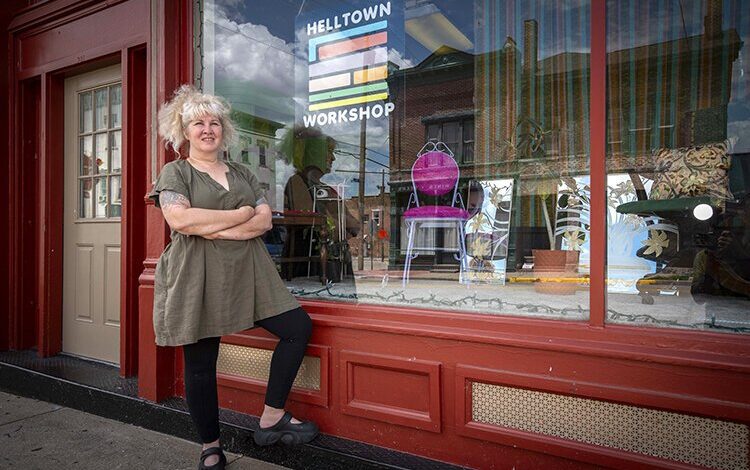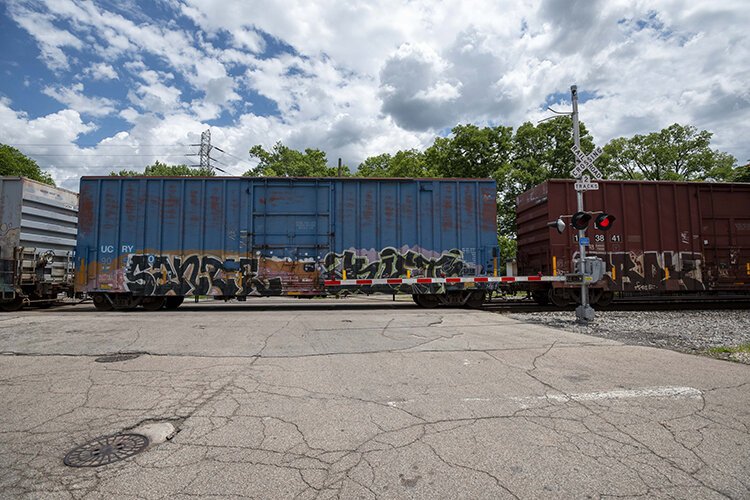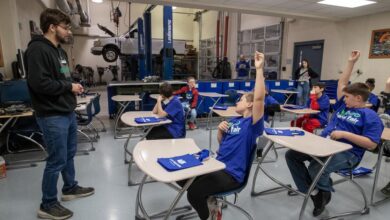Towns work to reconnect neighborhoods divided by trains and automobiles

The ways the 49 Hamilton County cities, villages, townships, and municipal corporations not only adjust but thrive is the focus of this series, First Suburbs—Beyond Borders. The series explores the diversity and ingenuity of these longstanding suburban communities, highlighting issues that demand collective thought and action to galvanize their revitalization.
One of the many quirks of getting around in Cincinnati is an unusual bit of highway engineering known as the Lockland Split. As it travels north from the city, Interstate 75 divides just after Cross County Highway. Northbound motorists veer to the east to travel an elevated highway that rises above the community below. In the southbound lanes, drivers enter the “Lockland Canyon,” as the highway is hemmed in by 20-foot concrete walls. The northbound and southbound lanes are acres apart, only to be joined again less than a mile later.
The Split, created when I-75 was constructed in the 1950s, effectively created a no-man’s land between the north and southbound lanes of one of America’s busiest interstates. About 10 square blocks of the village of Lockland, population 3,500, are surrounded by I-75. The situation is even more dramatic in neighboring Arlington Heights, where the Split nearly encircles the entire village, population 800.
Completed in the 1950s in the heyday of the postwar boom, Interstate 75 connects Michigan to Florida, and today carries more than 120,000 vehicles a day past the village. It’s a major artery for the nation’s commerce and car travel, but for communities bisected by its concrete and endless stream of high-speed traffic, I-75 is a permanent fact of life that has had a big impact – for better or for worse – on their quality of life.
Lockland, Arlington Heights, and four of their neighboring communities are beginning to figure out how to restore the small-town connections they were founded on before the interstate highway carved them up. That will be the subject of a study funded by the U.S. Department of Transportation, which awarded $300,000 to Hamilton County to hire a consultant to do an in-depth analysis. The grant was part of $3.3 billion awarded in March by the federal government to 132 communities around the country aimed at reconnecting communities that were cut off by transportation infrastructure decades ago, leaving neighborhoods with difficult access to schools, jobs, medical offices, and places of worship.
The towns of Lincoln Heights, Reading, Evendale, and Sharonville will also be included in the study, called Reconnecting Communities and Neighborhoods. “We all have common, long standing problems of how we’re going to move between communities,” says Michele Gottschlich, an Evendale resident and longtime community activist who chairs the Connecting Active Communities Coalition, a group of about a dozen first-ring suburbs.
The planning effort comes as transportation officials plan to eliminate the Lockland Split by demolishing the eastern leg and building new northbound lanes next to the current southbound lanes. That project is still years down the road.
While the highway has left an indelible mark on those towns, the railroad has been an even greater obstacle. “We’re also going to be focused on the presence of multiple freight railway lines that run through that area,” says Luke Ourednik, a Hamilton County planner who’s working on the project.
Lockland is hemmed in by rail lines on its eastern and western borders. Those lines eventually merge at the Queensgate rail yard, and trains from competing rail companies can cause a backup as they wait for another train, which can be a mile or more long, to be processed. Those delays regularly cause trains to stop and block traffic in Lockland, sometimes for hours.
 A stopped train blocks Dunn Street in Lockland. “Businesses say that they can’t expect regular shipments or deliveries of goods when they don’t know if the train is going to be parked for four hours or more,” Ourednik says. “It’s been economically hampered by the presence of the railway. In some communities, railways can be an asset, but in these communities they really do not give themselves much space to be an asset.”
A stopped train blocks Dunn Street in Lockland. “Businesses say that they can’t expect regular shipments or deliveries of goods when they don’t know if the train is going to be parked for four hours or more,” Ourednik says. “It’s been economically hampered by the presence of the railway. In some communities, railways can be an asset, but in these communities they really do not give themselves much space to be an asset.”
Gottschlich has worked on plans to create safe routes to school in Lockland and Evendale — “something simple like how are we going to get these kids safely to school,” she says. “I have seen kids climbing over parked railroad cars because they’re trying to get to school on time.”
The study and resultant plan should address those issues. It will also take into account a budding historic district around the intersection of Mill and Dunn streets in Lockland. The neighborhood has attracted investment from entrepreneurs and others drawn by its inventory of buildings from the late 19th and early 20th centuries and a streetscape with sidewalks, storefronts, and broad avenues.
Helen Smith moved her upholstery business, Helltown Workshop, from the Cincinnati neighborhood of Northside to Dunn Street. She was persuaded to move it there by Todd Snapp, a Chicago-based architect who grew up nearby in Reading. His parents still live in the area and he travels back and forth from Chicago frequently. On one of his visits a couple of years ago he happened to see a historic building for sale at the corner of Mill and Dunn. He bought it and began restoring the storefront. Upstairs, a small ballroom has been outfitted with couches and chairs, a few table, a tiny bar, and the stage holds sound gear and a drum kit ready for live performances.
When noted film maker Jeff Nichols saw the building, he chose it as the centerpiece of his upcoming movie, “The Bikeriders,” scheduled to be released June 21. The corner store was transformed into a ‘60s era, blue-collar biker bar, and much of the movie takes place there. The cast (which includes Austin Butler, Tom Hardy, and Jodie Comer) hung out in the ballroom after the day’s filming was over, and the weeks of filming generated significant buzz.
“That really helped change a lot of things and bring some energy into the area,” Snapp says.
Earlier this month, Smith, Snapp and other organized a Saturday outdoor maker’s market where vintage clothing, antiques, collectibles, as well as gourmet food prepared by Melissa Mileto, owner of the now-closed Take the Cake bakery in Northside, were available. More than 200 people showed up.

 Joe SimonA Saturday maker’s market at Mill and Dunn in Lockland.Snapp has organized planning meetings in the ballroom for community groups interested in the future of the Mill Creek valley towns, and has purchased other fixer-upper commercial properties in Lockland.
Joe SimonA Saturday maker’s market at Mill and Dunn in Lockland.Snapp has organized planning meetings in the ballroom for community groups interested in the future of the Mill Creek valley towns, and has purchased other fixer-upper commercial properties in Lockland.
Just to the north of Mill and Dunn sits 14 acres that once was the home of the Stearns and Foster mattress factory, once a cornerstone of Lockland employment. Earlier this year, Chicago-based Pepper Construction completed a comprehensive renovation of the 110-year-old Stearns and Foster administrative building and moved the employees of its Cincinnati regional office there. The factory itself closed in 2001, and then was demolished after a massive fire. Its site has been prepared for redevelopment, but questions about the I-75 project and the gridlocked trains may be holding back potential developers.
“All these complexities of the highway, the trains, the 14-acre site to the north, just demand this sort of step-back, broader study of the area and how all these neighborhoods can really work together and create connectivity,” Snapp says.
The First Suburbs—Beyond Borders series is made possible with support from a coalition of stakeholders including the Murray & Agnes Seasongood Good Government Foundation – The Seasongood Foundation is devoted to the cause of good local government; Hamilton County Planning Partnership; plus First Suburbs Consortium of Southwest Ohio, an association of elected and appointed officials representing older suburban communities in Hamilton County, Ohio.



